Circulating tumor cells help diagnostics for a tailor-made therapy in the fight against cancer

The BMBF-funded project CTCelect is making significant progress in the investigation of isolated circulating tumor cells (CTCs). In an integrated approach including user surveys as well as ethical and legal aspects, the consortium has developed and tested a system for CTC isolation over the last four years, which is robust and easy to use for the user and is based on the patient-friendly collection of a single blood sample. With the help of the development status of the open and thus flexibly applicable CTCelect system validated on real samples, extensive new results in medical research are made possible.
In cancer research, circulating tumor cells (CTCs) in the blood of patients are seen as an important source of information about the progress of the disease and possible therapeutic approaches. The focus of the BMBF-funded project CTCelect was on the technical side finding, isolating and separating these very rare CTCs in a single fully automated process. If the cells are intact after the fully automated isolation, their genetic and molecular biological properties can be examined and conclusions can be drawn about how individual tumor cells react to a treatment. This opens up a wide range of possible applications in the field of basic research, diagnostics and therapy optimization. All that is required for this is a 7.5 ml whole blood sample from the patient.
"The development team around project manager Dr. Sabine Alebrand has done an excellent job of turning an initial prototype developed in preliminary projects into a robust and user-friendly demonstrator that opens up valuable options in research on personalized cancer therapy," says Dr. Michael Baßler, head of the Diagnostics Division at Fraunhofer IMM and consortium leader of the CTCelect project. "Using preclinical models, we were able to reliably isolate morphologically intact cells.“ (oder "We were able to reliably isolate morphologically intact cells using preclinical models.“ Was ist besser?)
However, it is not just the technical and medical aspects that determine whether patients can benefit from the CTCelect system, but also ethical aspects, user requirements and economic issues. The experts at Fraunhofer ISI brought this perspective to the table. "We have learned from future users that the design of the system must differ fundamentally depending on whether it is to be used in a research context or in routine care" reports Dr. Heike Aichinger, project manager at Fraunhofer ISI. "For a commercial product development, therefore, the target group must be considered in time and their needs implemented in the technical development.“
The true verification of functionality takes place, however, when the system is operated with real samples by the user, in this case the Institute for Translational Skin Cancer Research (TSCR) at the University Hospital Essen. The first results on the enrichment and subsequent analysis of circulating tumor cells at the end of the project are very promising. "The open platform of the CTCelect system allowed us not only to use classical markers for enrichment of circulating tumor cells, but also to isolate cells that have lost these markers" explains Prof. Dr. Dr. Jürgen C. Becker, head of the TSCR, a division of the German Cancer Consortium (Deutsches Krebskonsortium -
DKTK) at the Medical Faculty of the University of Duisburg-Essen. „The subsequent molecular analyzes of the individual cells clearly confirmed that they were indeed tumor cells. These analyses enable completely new insights into the heterogeneity of tumors and thus explain the often difficult to predict response or failure of therapies." Further studies will investigate these questions intensively.
"Currently, we are primarily addressing the research market with this development in order to prove the necessary validity of the results," says Baßler. "In the future, the additional direct use in diagnostics is possible without radical changes to the system and is of course considered." On the agenda for the coming months is the validation with further tumor entities in order to subsequently enter into more extensive medical studies with suitable partners. "For this, however, both the focus on greater throughput and parallelization are important milestones. We would very much like to take these development steps together with interested partners from industry," Baßler emphasizes in conclusion.
 Fraunhofer Institute for Microengineering and Microsystems IMM
Fraunhofer Institute for Microengineering and Microsystems IMM